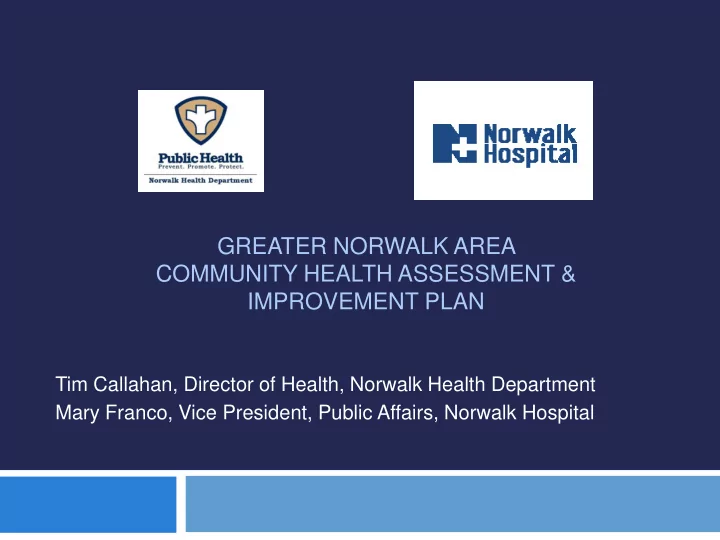

GREATER NORWALK AREA COMMUNITY HEALTH ASSESSMENT & IMPROVEMENT PLAN Tim Callahan, Director of Health, Norwalk Health Department Mary Franco, Vice President, Public Affairs, Norwalk Hospital
History of Collaboration 2 Previous community health assessment 2000 Jointly established FQHC 1999 Elementary school obesity project Numerous community health initiatives eg. Lyme Disease, caccooning project, etc.
Current Collaboration 3 Community Health Assessment 2012 Community Health Improvement Plan 2013- 2016 Various projects Homelessness Education
How Did We Engage the Community? 4 Chose ACHI model prior to engaging group Created compelling story Brainstormed who we needed, who knew who Personal calls to personal contacts Followed up with letter outlining process Asked community who else should be at table Respect for their time was key
Task Force Makeup 5 Initially 40 members from 30 organizations Representing health care, public health, education, public safety, mental health, social services, business, senior services, elected officials, and transportation, seniors, youth Task Force continued to expand and diversify as the project progressed 225 unique individuals engaged includes community residents and representatives from organizations.
Tools for Engagement On-line tools (Constant Contact) for Core Leadership Personal letters Telephone calls Site visits Focus Groups Interviews Ongoing meetings Organization structure established
Core Team Roles 7 Coordinated overall assessment process Motivated community organizations and community members to participate Hired consultant to collect/analyze primary data RFP development (Health Department) RFP release and coordination of applicant selection (Hospital) Paid for the majority of the assessment costs (Hospital) Recruited and managed focus groups & interviews Collected primary & secondary data Analyzed secondary data (Health Department) Motivated community to act on priority issues Recruiting CHIP workgroup participants Continuous media outreach (Hospital) Continuous partner electronic communications (Health Department)
Task Force Roles 8 Provided quantitative & qualitative data Identified additional secondary data sources Provided input on qualitative data collection Motivated and recruited community members Participated in focus groups & interviews Assisted in organizing and conducting focus groups Provided technical assistance in areas of expertise Identified priority issues for health improvement Participating in CHIP development and implementation
Explored Health Equity 9 Engaged representatives from multiple sectors influencing health, such as education, housing, business development, transportation, and public safety Synthesized secondary data on social, economic, and health indicators in the region and primary qualitative information. Utilized US Census, County Health Rankings and utilized Health Equity Data When possible, analyzed data to determine who is impacted most (disparities and inequities) and what changes occurred over time (trends) Analyzed quantitative data to determine how it matched up with community member perceptions
Aligned with National Initiatives 10 Healthy People 2020 benchmarks National Prevention Strategy priorities Preventing drug abuse and excessive alcohol use, healthy eating, active living, mental and emotional well-being CDC Winnable Battles Nutrition, Physical Activity, Obesity Source: Behavioral Risk Factor Surveillance System (BRFSS), 2010 **relevant Healthy People 2020 Target, not available
Challenges 11 Costly – time & money Staff capacity Other large-scale community projects being conducted concurrently Scarce local quantitative data Striking a balance between community-driven strategy selection and ensuring strategies are feasible, aligned with national recommendations Trying Not To Boil The Ocean
Successes 12 Identification of community strengths and needs Creating understanding of local data Strengthening our partnership Positioned as leaders in community Creating new and enhanced relationships High level of community interest and commitment Silos and Barriers Shrinking
Community Health Committee 13 Composed of representatives of the community, partner organizations, health departments, hospital Guide and monitor Community Health Improvement Plan Monitor Community Benefit Charity care Community health programs Health improvement plan Provide guidance for regulatory reporting
CHIP Working Structure 14 Norwalk Hospital Norwalk Greater Norwalk Board of Department Region Trustees of Health Board Community Health Committee Mental Health/ Obesity Substance Community Initiative Abuse Health Committee Initiative Task Force Committee Workgroup Workgroup Workgroup Workgroup Workgroup Workgroup
CHIP Initiative 1: Mental Health/Substance Abuse 15 Goal: Provide education on and access to quality, evidence-based mental health and substance abuse prevention, intervention and treatment services across the life span. Objective 1.1: Increase providers’ and community members’ awareness and use of evidence-based mental health and substance abuse services and educational resources for prevention, intervention, treatment and recovery Objective 1.2: Enhance local and regional partnerships to improve access to timely, comprehensive, and coordinated services for diverse populations across the life span Objective 1.3: Reduce financial barriers to treatment
CHIP Initiative 2: Obesity/Healthy Lifestyle 16 Goal: Prevent and reduce obesity in the community by promoting healthy lifestyles. Objective 2.1: Increase the number of children and adults who meet physical activity guidelines Objective 2.2: Increase access to and consumption of healthy foods throughout the region
Questions 17 For more detailed information, please visit: www.norwalkhospital.org
Recommend
More recommend